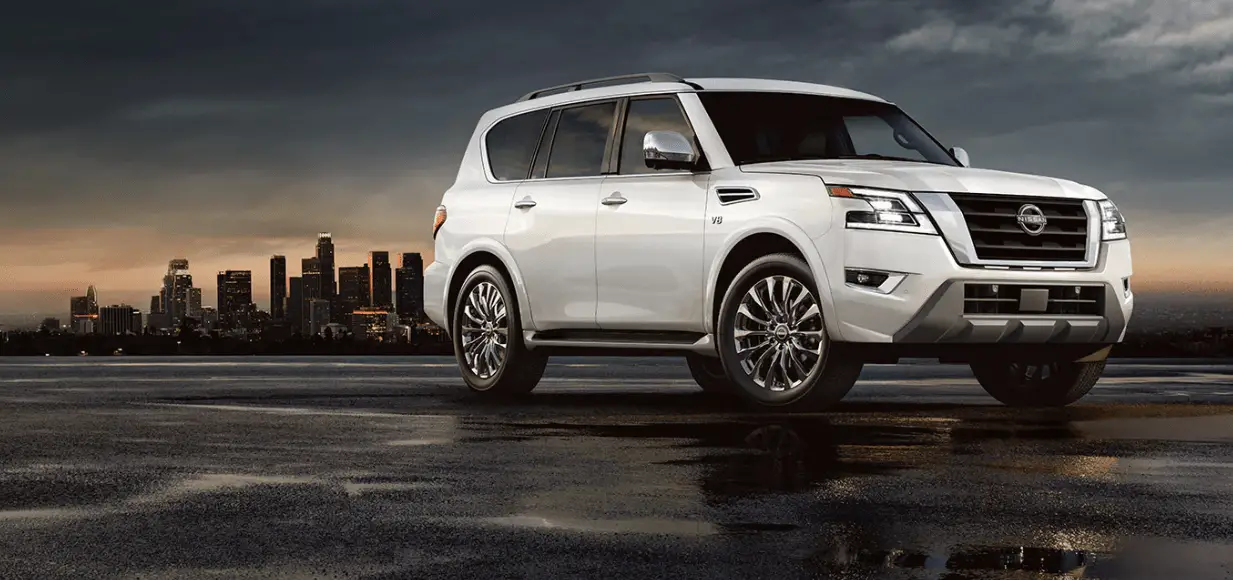Nissan ARMADA 2022 Towing a trailer and Uniform tire quality grading
The 2022 Nissan Armada is a strong and reliable vehicle when it comes to safety and versatility. It has the power and ability to pull trailers, and it also has a commitment to tyre quality that is shown in the Uniform Tyre Quality Grading (UTQG) system. The Armada has a large towing capacity that makes pulling a caravan easy. This capacity can be used for a variety of fun and practical purposes, such as transporting boats, campers or other goods. To fully use its pulling power, however, one must learn how to deal with weight distribution, trailer brakes, and towing equipment that doesn’t work with the vehicle. The Armada also follows the UTQG system, which makes sure that its tyres have standard grades for treadwear, traction, and temperature resistance. This gives drivers useful information about how well the tyres work and how long they last. As we start this detailed guide, we’ll talk about towing with the 2022 Armada and the importance of UTQG ratings in choosing tyres and keeping them in good shape. This will give you a full picture of how these different factors work together to make your car ride safer and more efficient.
2023 Nissan Armada Specs, Price, Features and Mileage (Brochure)
TOWING A TRAILER
WARNING
Overloading or improper loading of a trailer and its cargo can adversely affect vehicle handling, braking and performance and may lead to accidents.
CAUTION
- Do not tow a trailer or haul a heavy load for the first 500 miles (800 km). Your engine, axle or other parts could be damaged.
- For the first 500 miles (800 km) that you tow a trailer, do not drive over 50 MPH (80 km/h) and do not make starts at full throttle. This helps the engine and other parts of your vehicle wear in at heavier loads.
Your new vehicle was designed to be used primarily to carry passengers and cargo. Remember that towing a trailer places additional loads on your vehicle’s engine, drivetrain, steering, braking and other systems. A NISSAN Towing Guide (U.S. only) is available on the website at
www.nissanusa.com. This guide includes information on trailer towing capability and the special equipment required for proper towing.
MAXIMUM LOAD LIMITS
Maximum trailer loads
Never allow the total trailer load to exceed the value specified in the “Towing load/specification. The total trailer load equals trailer weight plus its cargo weight.
- When towing a trailer load of 3,500 lbs (1,587 kg) or more, trailers with a brake system MUST be used.
The maximum Gross Combined Weight Rating (GCWR) should not exceed the value specified in the following “Towing Load/Specification” chart.
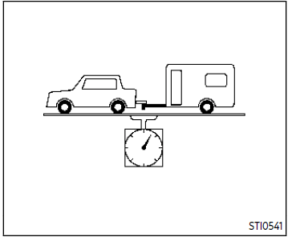
The GCWR equals the combined weight of the towing vehicle (including passengers and cargo) plus the total trailer load. Towing loads greater than these or using improper towing equipment could adversely affect vehicle handling, braking and performance.
The ability of your vehicle to tow a trailer is not only related to the maximum trailer loads but also the places you plan to tow. Tow weights appropriate for level high-way driving may have to be reduced on very steep grades or for low traction situations (for example, on slippery boat ramps).
Temperature conditions can also affect 10-20 Technical and consumer information towing. For example, towing a heavy trailer in high outside temperatures on graded roads can affect engine performance and cause overheating. The transmission’s high fluid temperature and engine protection mode, which helps reduce the chance of transmission and engine damage, could activate and automatically decrease engine power. Vehicle speed may decrease under high load. Plan your trip carefully to account for trailer and vehicle load, weather and road conditions.
WARNING
Overheating can result in reduced engine power and vehicle speed. The reduced speed may be lower than other traffic, which could increase the chance of a collision. Be especially careful when driving. If the vehicle cannot maintain a safe driving speed, pull to the side of the road in a safe area. Allow the engine to cool and return to normal operation.
CAUTION
Vehicle damage resulting from improper towing procedures is not covered by NISSAN warranties.
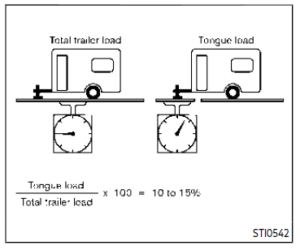
Tongue load
When using a weight-carrying or a weight-distributing hitch, keep the tongue load between 10 to 15% of the total trailer load or use the trailer tongue load specified by the trailer manufacturer. The tongue load must be within the maximum tongue load limits shown in the following “Towing Load/Specification” chart. If the tongue load becomes excessive, rearrange cargo to allow for proper tongue load.
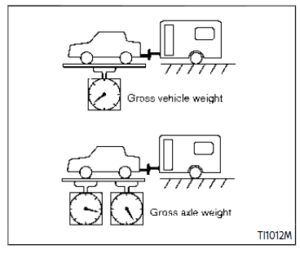
MAXIMUM GROSS VEHICLE WEIGHT
(GVW)/MAXIMUM GROSS AXLE
WEIGHT (GAW)
The GVW of the towing vehicle must not exceed the Gross Vehicle Weight Rating (GVWR) shown on the F.M.V.S.S./C.M.V.S.S. certification label. The GVW equals the combined weight of the unloaded vehicle, passengers, luggage, hitch, trailer tongue load and any other optional equipment. In addition, front or rear GAW must not exceed the Gross Axle Weight Rating (GAWR) shown on the F.M.V.S.S./C.M.V.S.S. certification label.
Towing capacities are calculated assuming a base vehicle with driver and any options required to achieve the rating. Additional passengers, cargo and/or optional equipment, such as the trailer hitch, will add weight to the vehicle and reduce your vehicle’s maximum towing capacity and trailer tongue load.
The vehicle and trailer need to be weighed to confirm the vehicle is within the GVWR, Front GAWR, Rear GAWR, Gross Combined Weight Rating (GCWR) and Towing capacity.
All vehicle and trailer weights can be measured using platform-type scales commonly found at truck stops, highway weigh stations, building supply centers or salvage yards.
To determine the available payload capacity for tongue/kingpin load, use the following procedure.
- Locate the GVWR on the F.M.V.S.S./C.
M. V.S.S. certification label. - Weigh your vehicle on the scale with all of the passengers and cargo that are normally in the vehicle when towing a trailer.
- Subtract the actual vehicle weight from the GVWR. The remaining amount is the available maximum tongue/kingpin load.
To determine the available towing capacity, use the following procedure.
- Find the GCWR for your vehicle on the “Towing Load/Specification” chart found later in this section.
- Subtract the actual vehicle weight from the GCWR. The remaining amount is the available maximum towing capacity.
To determine the Gross Trailer Weight, weigh your trailer on a scale with all equipment and cargo, that are normally in the trailer when it is towed. Make sure the Gross trailer weight is not more than the Gross Trailer Weight Rating shown on the trailer and is not more than the calculated available maximum towing capacity.
Also weigh the front and rear axles on the scale to make sure the Front Gross Axle Weight and Rear Gross Axle Weight are not more than Front Gross Axle Weight and Rear Gross Axle Weight on the F.M.V.S. S./C.M.V.S.S. certification label. The cargo in the trailer and vehicle may need to be moved or removed to meet the specified ratings.
Example:
- Gross Vehicle Weight (GVW) as weighed on a scale – including passengers, cargo and hitch – 5,822 lb.(2,641 kg).
- Gross Vehicle Weight Rating (GVWR)
from F.M.V.S.S./C.M.V.S.S. certification label – 7,300 lb. (3,311 kg). - Gross Combined Weight Rating (GCWR) from “Towing Load/Specification” chart – 14,520 lb. (6,586 kg).
- Maximum Trailer towing capacity from “Towing Load/Specification” chart – 8,500 lb. (3,856 kg).
- 7,300 lb. (3,311 kg) GVWR
- − 5,822 lb. (2,641 kg) GVW
- = 1,478 lb. (670 kg)
- Available for tongue
- weight
- 14,520 lb. (6,586 kg) GCWR
- − 5,822 lb. (2,641 kg) GVW
- = 8,698 lb. (3,945 kg)
- Capacity available for
- towing
- 1,478 lb. (670 kg) /
- Available tongue
- weight
- 8,698 lb. (3,945 kg) Available capacity
- = 11 % tongue weight
The available towing capacity may be less than the maximum towing capacity due to the passenger and cargo load in the vehicle.
Remember to keep trailer tongue weight between 10 – 15% of the trailer weight or within the trailer tongue load specification recommended by the trailer manufacturer. If the tongue load becomes excessive, rearrange the cargo to obtain the proper tongue load. Do not exceed the maximum tongue weight specification shown in the “Towing load/specification” chart even if the calculated available tongue weight is greater than 15%. If the calculated tongue weight is less than 10%, reduce the total trailer weight to match the available tongue weight.
Always verify that available capacities are within the required ratings.
TOWING LOAD/SPECIFICATION
WARNING
The towing capacities provided in this manual are for general reference only. The safe towing capacity of your vehicle is affected by dealer and factory installed options and passenger and cargo loads. You must weigh the vehicle and trailer as described in this manual to determine the actual vehicle towing capacity. Do not exceed the published maximum towing capacity, or the GCWR or the GVWR shown on the F.M.V.S.S./C.M.V.S.S. certification label. Doing so can result in an accident causing serious personal injury or property damage.
| Towing Load/Specification Chart | |||
| US | Canada | ||
| Axle Type | Two-wheel drive (2WD) | Four-wheel drive (4WD) | Four-wheel drive (4WD) |
| Maximum Towing Capacity*1, *2 | 8,500 lb (3,856 kg) | 8,500 lb (3,856 kg) | |
| Maximum Tongue Load | 850 lb (385 kg) | 850 lb (385 kg) | |
| Maximum Gross Combined Weight Rating | 14,520 lb (6,586 kg) | 14,760 lb (6,695 kg) | 14,770 lb
(6,700 kg) |
- The towing capacity values are calculated assuming a base vehicle with driver and any options required to achieve the rating. Additional passengers, cargo and/or optional equipment will add weight to the vehicle and reduce your vehicle’s maximum towing capacity.
- Use of a weight-distributing hitch system is recommended when towing over 5,000 lb (2,267 kg).
TOWING SAFETY
Trailer hitch
Your vehicle is equipped with a trailer tow package. The trailer tow package includes a receiver-type frame-mounted hitch. This hitch is rated for the maximum towing capacity of this vehicle when the proper towing equipment is used. Choose a proper ball mount and hitch ball that is rated for the trailer to be towed. Genuine NISSAN ball mounts and hitch balls are available from a NISSAN dealer.
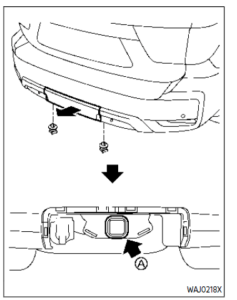
To access the trailer hitch, remove the trailer hitch cover located on the lower part of the rear bumper.
To remove the trailer hitch cover:
- Remove the 2 clips.
- Pull the bottom of the cover straight backwards to remove the inner side and upper clips.

To install the trailer hitch cover:
- Insert the upper clips to the recesses, and then push in the cover to its original position.
- Install the 2 clips.
WARNING
Trailer hitch components have specific weight ratings. Your vehicle may be capable of towing a trailer heavier than the weight rating of the hitch components. Never exceed the weight rating of the hitch components. Doing so can cause serious personal injury or property damage.
Hitch ball
Choose a hitch ball of the proper size and weight rating for your trailer:
- The required hitch ball size is stamped on most trailer couplers. Most hitch balls also have the size printed on top of the ball.
- Choose the proper class hitch ball based on the trailer weight.
- The diameter of the threaded shank of the hitch ball must be matched to the ball mount hole diameter. The hitch ball shank should be no more than 1/16″ smaller than the hole in the ball mount.
- The threaded shank of the hitch ball must be long enough to be properly secured to the ball mount. There should be at least 2 threads showing beyond the lock washer and nut.
Ball mount
The hitch ball is attached to the ball mount and the ball mount is inserted into the hitch receiver. Choose a proper class ball mount based on the trailer weight. Additionally, the ball mount should be chosen to keep the trailer tongue level with the ground.
Weight carrying hitches
A weight-carrying or “dead weight” ball mount is designed to carry the whole amount of tongue weight and gross weight directly on the ball mount and on the receiver.
Weight distribution hitch
This type of hitch is also called a “load-levelling” or “equalizing” hitch. A set of bars is attached to the ball mount and to the trailer to distribute the tongue weight (hitch weight) of your trailer. Many vehicles cannot carry the full tongue weight of a given trailer and need some of the tongue weight transferred through the frame and pushing down on the front wheels. This gives stability to the tow vehicle.
A weight-distributing hitch system (Class IV) is recommended if you plan to tow trailers with a maximum weight over 5,000 lbs (2,267 kg). Check with the trailer and towing equipment manufacturers to determine if they recommend the use of a weight-distributing hitch system.
NOTE:
A weight-distributing hitch system may affect the operation of trailer surge brakes. If you are considering use of a weight-distributing hitch system with a surge brake-equipped trailer, check Technical and consumer information 10-25 with the surge brake, hitch or trailer manufacturer to determine if and how this can be done.
Follow the instructions provided by the manufacturer for installing and using the weight-distributing hitch system.
General set-up instructions are as follows:
- Park unloaded vehicle on a level surface. With the ignition switch in the ON position and the doors closed, allow the vehicle to stand for several minutes so that it can level.
- Measure the height of a reference point on the front and rear bumpers at the centre of the vehicle.
- Attach the trailer to the vehicle and adjust the hitch equalizers so that the front bumper height is within 0 – .5 inches (0 – 13 mm) of the reference height measured in step 2. The rear bumper should be no higher than the reference height measured in step 2.
WARNING
Properly adjust the weight-distributing hitch so the rear of the bumper is no higher than the measured reference height when the trailer is attached. If the rear bumper is higher than the measured reference height when loaded, the vehicle may handle unpredictably which could cause a loss of vehicle control and cause serious personal injury or property damage.
Sway control device
Sudden manoeuvres, wind gusts and buffeting caused by other vehicles can affect trailer handling. Sway control devices may be used to help control these effects. If you choose to use one, contact a reputable trailer hitch supplier to make sure the sway control device will work with the vehicle, hitch, trailer and the trailer’s brake system. Follow the instructions provided by the manufacturer for installing and using the sway control device.
Class I hitch
Class I trailer hitch equipment (receiver, ball mount and hitch ball) can be used to tow trailers of a maximum weight of 2,000 lb (907 kg).
Class II hitch
Class II trailer hitch equipment (receiver, ball mount and hitch ball) can be used to tow trailers of a maximum weight of 3,500 lb (1,588 kg).
Class III hitch
Class III trailer hitch equipment (receiver, ball mount and hitch ball) can be used to tow trailers of a maximum weight of 5,000 lb (2,267 kg).
Class IV hitch
Class IV trailer hitch equipment (receiver, ball mount and hitch ball) can be used to tow trailers of a maximum weight of 10,000 lb (4,545 kg). A weight-distributing hitch should be used to tow trailers that weigh over 5,000 lb (2,267 kg).
Your vehicle may be equipped with Class IV trailer hitch equipment that has a 10,000 lb (4,545 kg) maximum weight rating, but your vehicle is only capable of towing the maximum trailer weights shown in the “Towing Load/Specification” chart earlier in this section.
CAUTION
- Do not use axle-mounted hitches.
- Do not modify the vehicle exhaust system, brake system, etc.
- Do not attach any additional hitches to your vehicle because a hitch is already mounted to your vehicle frame.
Tire pressures
- When towing a trailer, inflate the vehicle tires to the recommended cold tire pressure indicated on the Tire and Loading Information label.
- Trailer tire condition, size, load rating and proper inflation pressure should be by the trailer and tire manufacturer’s specifications.
Safety chains
Always use a suitable chain between your vehicle and the trailer. The safety chains should be crossed and should be attached to the hitch, not to the vehicle bumper or axle. Be sure to leave enough slack in the chains to permit turning corners.
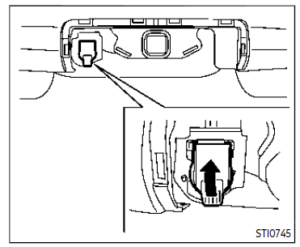
Trailer lights (if so equipped)
Your vehicle is equipped with a towing package, which also includes the 7-pin trailer harness connector located under the trailer hitch cover on the rear bumper.
CAUTION
- When splicing into the vehicle’s electrical system, a commercially available power-type module/converter must be used to provide power for all trailer lighting. This unit uses the vehicle battery as a direct power source for all trailer lights while using the vehicle tail light, stoplight and turn signal circuits as a signal source. The module/converter must draw no more than 15 milliamps from the stop and tail lamp circuits. Using a module/converter that exceeds these power requirements may damage the vehicle’s electrical system. See a reputable trailer retailer to obtain the proper equipment and to have it installed.
- Do not connect electrical devices that draw more than 40 amps to the vehicle. The fusible link may melt.
Trailer lights should comply with federal and/or local regulations. For assistance in hooking up trailer lights, contact a NISSAN dealer or reputable trailer retailer.
Trailer brakes
When towing a trailer load of 3,500 lbs.(1,587 kg) or more, trailers with a brake system MUST be used. However, most states require a separate braking system on trailers with a loaded weight above a specific amount. Make sure the trailer meets the local regulations and the regulations where you plan to tow. Several types of braking systems are available.
Surge Brakes – The surge brake actuator is mounted on the trailer tongue with a hydraulic line running to each trailer wheel. Surge brakes are activated by the trailer pushing against the hitch ball when the tow vehicle is braking. Hydraulic surge brakes are common on rental trailers and some boat trailers. In this type of system, there is no hydraulic or electric connection for brake operation between the tow vehicle and the trailer.
Electric Trailer Brakes – Electric braking systems are activated by an electronic signal sent from a trailer brake controller (special brake sensing module).
Have a professional supplier of towing equipment make sure the trailer brakes are properly installed and demonstrate proper brake function testing.
WARNING
Never connect a trailer brake system directly to the vehicle brake system.

- Gain –
- Gain +
- Manual control lever
- Boost
Trailer Brake Controller Unit (TBCU)
(if so equipped)
The Trailer Brake Controller Unit (TBCU), located on the lower instrument panel, is a device that assists the vehicle in having effective and smooth braking while towing a trailer.
Operating modes:
- Automatic mode:
This is the normal operation of the TBCU depending on the gain and boost settings adjusted by the customer. This mode will activate when vehicle brake pedal is pressed. - Manual mode:
This mode is initiated by adjusting the manual control lever from the resting position. This mode will provide out-put power to trailer brakes without applying the vehicle brake pedal.
To determine the output operation of the system: - Gain + and Gain – :
Used to increase or decrease the braking force supplied to the trailer brakes. To adjust the gain, press Gain + or Gain – to the desired point (0-10). For example: gain setting 6.0 is a typical starting point for heavy loads. - Boost:
Used to adjust the feel of the automatic brake event that occurs when the vehicle brake pedal is applied. To set up boost, press Boost button once to display for current boost setting (display for 3 seconds). Keep pressing to increase the boost level until the desired level (0-3) is achieved. - Manual Control Lever:
Provides brake output power to trailer brakes without applying the vehicle brake pedal. The amount of brake output supplied corresponds to the amount of pinch pressure applied to the manual control lever. - Prodigy® P2 initial screen at startup (15 seconds*)
- Power to Prodigy® P2 with trailer connected and boost feature not engaged
- Power to Prodigy® P2 with trailer connected and boost feature not engaged
- Power to Prodigy® P2, trailer not connected
- Boost off
- Boost level 1
- Boost level 2
- Boost level 3
Gain feature is adjustable by increments of

This graphic shows the suggested boost levels for different trailer sizes relative to the vehicle size.
WARNING
Do not exceed Gross Combined Weight Rating (GVWR).
Pre-towing tips
- Be certain your vehicle maintains a level position when a loaded or unloaded trailer is hitched. Do not drive the vehicle if it has an abnormal nose-up or nose-down condition; check for improper tongue load, overload, worn suspension or other possible causes of either condition.
- Always secure items in the trailer to
prevent load shift while driving. - Keep the cargo load as low as possible in the trailer to keep the trailer’s centre of gravity low.
- Load the trailer so approximately 60% of the trailer load is in the front half and 40% is in the back half. Also make sure the load is balanced side to side.
- Check your hitch, trailer tire pressure, vehicle tire pressure, trailer light operation, and trailer wheel lug nuts every time you attach a trailer to the vehicle.
- Be certain your rearview mirrors con- form to all federal, state or local regulations. If not, install any mirrors required for towing before driving the vehicle.
- Determine the overall height of the vehicle and trailer so the required clearance is known.
Trailer towing tips
To gain skill and an understanding of the vehicle’s behaviour, you should practice turning, stopping and backing up in an area which is free from traffic. Steering stability, and braking performance will be somewhat different than under normal driving conditions.
- Always secure items in the trailer to prevent load shift while driving.
- Lock the trailer hitch coupler with a pin or lock to prevent the coupler from inadvertently becoming unlatched.
- Avoid abrupt starts, acceleration or stops.
- Avoid sharp turns or lane changes. . Always drive your vehicle at a moderate speed. Some states or provinces have specific speed limits for vehicles that are towing trailers. Obey the local speed limits.
- When backing up, hold the bottom of the steering wheel with one hand. Move your hand in the direction in which you want the trailer to go. Make small corrections and back up slowly. If possible, have someone guide you when you are backing up.
Always block the wheels on both vehicle and trailer when parking. Parking on a slope is not recommended; however, if you must do so:
CAUTION
If you move the shift lever to the P (Park) position before blocking the wheels and applying the parking brake, transmission damage could occur.
- Apply and hold the brake pedal.
- Have someone place blocks on the downhill side of the vehicle and trailer wheels.
- After the wheel blocks are in place, slowly release the brake pedal until the blocks absorb the vehicle load.
- Apply the parking brake.
- Shift the transmission into P (Park).
- Four-Wheel Drive (4WD) models: Make sure that the 4WD shift switch is engaged in the AUTO, 4HI or 4LO position and the Automatic Transmission (AT) park warning light is turned off.
- Turn off the engine.
To drive away:
- Apply and hold the brake pedal.
- Start the engine.
- Shift the transmission into gear.
- Release the parking brake.
- Drive slowly until the vehicle and trailer are clear from the blocks.
- Apply and hold the brake pedal.
- Have someone retrieve and store the blocks.
- While going downhill, the weight of the trailer pushing on the tow vehicle may decrease overall stability. Therefore, to maintain adequate control, reduce your speed and shift to a lower gear. Avoid long or repeated use of the brakes when descending a hill, as this reduces their effectiveness and could cause overheating. Shifting to a lower gear instead provides “engine braking” and reduces the need to brake as frequently.
- If the engine coolant temperature rises to a high temperature
- Trailer towing requires more fuel than normal circumstances.
- Avoid towing a trailer for your vehicle’s first 500 miles (800 km).
- Have your vehicle serviced more often than at intervals specified in the recommended maintenance schedule shown in the “9. Maintenance and schedules” section.
- When making a turn, your trailer wheels will be closer to the inside of the turn than your vehicle wheels. To compensate for this, make a larger-than-normal turning radius during the turn.
- Crosswinds and rough roads will adversely affect vehicle/trailer handling, possibly causing vehicle sway. When being passed by larger vehicles, be prepared for possible changes in crosswinds that could affect vehicle handling.
2023 Nissan Armada Specs, Price, Features and Mileage (Brochure)
Do the following if the trailer begins to sway:
- Take your foot off the accelerator pedal to allow the vehicle to coast and steer as straight ahead as the road conditions allow. This combination will help stabilize the vehicle.
- Do not correct trailer sway by
steering or applying the brakes.
- Do not correct trailer sway by
- When the trailer sway stops, gently apply the brakes and pull to the side of the road in a safe area.
- Try to rearrange the trailer load so it is balanced as described earlier in this section.
- Be careful when passing other vehicles. Passing while towing a trailer requires considerably more distance than normal passing. Remember the length of the trailer must also pass the other vehicle before you can safely change lanes.
- Use the Tow mode or downshift the transmission to a lower gear for engine braking when driving down steep or long hills. This will help slow the vehicle without applying the brakes.
- Avoid holding the brake pedal down too long or too frequently. This could cause the brakes to overheat, resulting in reduced braking efficiency.
- Increase your following distance to allow for greater stopping distances while towing a trailer. Anticipate stops and brake gradually.
- NISSAN recommends that the cruise control not be used while towing a trailer.
- While towing a trailer, do not use the following systems (if so equipped):
- the Lane Departure Warning (LDW) system
- the Intelligent Lane Intervention (I- LI) system
- the Blind Spot Warning (BSW) system
- the Intelligent Blind Spot Intervention (I-BSI) system
- the Intelligent Back-up Intervention (I-BI) system
- the Intelligent Cruise Control (ICC) system
- the Rear Automatic Braking (RAB) system
- the Rear Cross Traffic Alert (RCTA) system
- Some states or provinces have specific regulations and speed limits for vehicles that are towing trailers. Obey the local speed limits.
- Check your hitch, trailer wiring harness connections, and trailer wheel lug nuts after 50 miles (80 km) of travel and at every break.
- When launching a boat, do not allow the water level to go over the exhaust tail pipe or rear bumper.
- Make sure you disconnect the trailer lights (if so equipped) before backing the trailer into the water or the trailer lights may burn out.
When towing a trailer, the transmission fluid should be changed more frequently. For additional information, see the “9. Maintenance and schedules” section.
TOW mode
Using TOW mode is recommended when pulling a heavy trailer or hauling a heavy load. Push the TOW MODE switch to activate tow mode. The TOW MODE indicator light in the meter illuminates when TOW mode is selected. Push the TOW MODE switch again to turn TOW mode off. TOW mode is automatically cancelled when the ignition switch is placed in the OFF position.
TOW mode includes the following features:
- Grade logic — Adjusts transmission shifts when pulling a trailer or hauling a load up a grade.
- Downhill Speed Control (DSC) — automatically downshifts when driving down a grade with a trailer or heavy load to help control vehicle speed.
Driving the vehicle in the TOW mode with no trailer/load or light trailer/light load will not cause any damage. However, fuel economy may be reduced and the trans-mission/engine driving characteristics may feel unusual.
When towing a trailer, the transmission fluid should be changed more frequently. For additional information, see the “9. Maintenance and schedules” section.
Trailer Sway Control
To minimize trailer sway, your vehicle may apply braking to individual wheels based on input from your vehicle sensors and vehicle speed. Trailer Sway Control is a function of the Vehicle Dynamic Control (VDC) system and is active when the VDC function is enabled.
CAUTION
If the VDC OFF switch is on (meaning VDC system OFF), the Trailer Sway Control is also disabled. When Trailer Sway Control is in operation, the VDC warning light blinks. When vehicle control is regained, VDC warning light will turn OFF.
If Trailer Sway Control activates:
- Take your foot off the accelerator pedal to allow the vehicle to coast and steer as straight ahead as the road conditions allow. This combination will help stabilize the vehicle.
CAUTION
Do not try to correct trailer sway by steering or applying the brakes. - When the trailer sway stops, gently apply the brakes and pull to the side of the road in a safe area.
- Try to rearrange the trailer load so it is balanced.
NOTE:
Trailer Sway Control cannot reduce trailer sway in all situations.
FLAT TOWING
Towing your vehicle with all four wheels on the ground is sometimes called flat towing. This method is sometimes used when towing a vehicle behind a recreational vehicle, such as a motor home.
CAUTION
- Failure to follow these guidelines can result in severe transmission damage.
- Whenever flat towing your vehicle, always tow forward, never backwards.
- DO NOT tow any automatic transmission vehicle with all four wheels on the ground (flat towing). Doing so WILL DAMAGE internal transmission parts due to lack of transmission lubrication.
- DO NOT tow a Four-Wheel Drive (4WD) vehicle with any of the wheels on the ground. Doing so may cause serious and expensive damage to the powertrain.
Automatic Transmission
Four-wheel drive (4WD) models:
Do not tow a 4WD vehicle with any of the wheels on the ground.
Two-wheel drive (2WD) models:
To tow a vehicle equipped with an automatic transmission, an appropriate vehicle dolly MUST be placed under the towed vehicle’s drive wheels. Always follow the dolly manufacturer’s recommendations when using their product.
UNIFORM TIRE QUALITY GRADING
DOT (Department Of Transportation) Quality Grades: All passenger car tires must conform to federal safety requirements in addition to these grades.
Quality grades can be found where applicable on the tire sidewall between tread shoulder and maximum section width. For example:
Treadwear 200 Traction AA Temperature A
TREADWEAR
The treadwear grade is a comparative rating based on the wear rate of the tire when tested under controlled conditions on a specified government test course. For example, a tire graded 150 would wear one and one-half (1 1/2) times as well on the government course as a tire graded 100. The relative performance of tires depends upon actual conditions of their use, however, and may depart significantly from the norm due to variations in driving habits, service practices and differences in road characteristics and climate.
TRACTION AA, A, B AND C
The traction grades, from highest to lowest, are AA, A, B and C. Those grades represent the tire’s ability to stop on wet pavement as measured under controlled conditions on specified government test surfaces of asphalt and concrete. A tire marked C may have poor traction performance.
WARNING
The traction grade assigned to this tire is based on straight-ahead braking traction tests, and does not include acceleration, cornering, hydroplaning, or peak traction characteristics.
TEMPERATURE A, B AND C
The temperature grades A (the highest), B, and C, represent the tire’s resistance to the generation of heat and its ability to dissipate heat when tested under controlled conditions on a specified indoor laboratory test wheel. Sustained high temperature can cause the material of the tire to degenerate and reduce tire life, and excessive temperature can lead to sudden tire failure. Grade C corresponds to a level of performance which all passenger car tires must meet under the Federal Motor Vehicle Safety Standard No. 109. Grades B and A represent higher levels of performance on the laboratory test wheel than the minimum required by law.
WARNING
The temperature grade for this tire is established for a tire that is properly inflated and not overloaded. Excessive speed, under-inflation, or excessive loading, either separately or in combination, can cause heat build-up and possible tire failure.
FAQ
The maximum towing capacity of the 2022 Nissan Armada can vary depending on the trim level and equipment, but it is generally rated for towing loads of over 8,000 pounds.
A suitable trailer hitch for towing with the Armada is typically a Class III or Class IV hitch, depending on your specific towing needs.
Yes, the Armada’s towing capacity often allows for towing travel trailers or campers, but it’s crucial to ensure that your trailer’s weight falls within the Armada’s towing limits.
Trailer brakes may be required or recommended, depending on the weight of the trailer. Check local regulations and the Armada’s specifications to determine if trailer brakes are necessary.
Distribute the trailer’s weight evenly and secure it properly to the hitch. Ensure that the trailer’s tongue weight is within the recommended range, typically 10-15% of the trailer’s total weight.
Yes, the Armada is often suitable for towing boats, but it’s essential to consider the weight of the boat and trailer when towing to stay within the vehicle’s towing capacity.
Uniform Tire Quality Grading (UTQG) is a standardized rating system used to provide information about a tire’s treadwear, traction, and temperature resistance characteristics.
The UTQG rating for the tires on your Armada can typically be found on the sidewall of the tire, often accompanied by a three-part code indicating treadwear, traction, and temperature resistance.
The treadwear rating indicates how long a tire is expected to last under specific test conditions. A higher treadwear rating generally suggests a longer-lasting tire.
The traction rating measures a tire’s ability to stop on wet pavement. Ratings include AA (highest), A, B, and C (lowest), with AA offering the best wet traction.
The temperature resistance rating indicates a tire’s ability to dissipate heat effectively. Ratings include A (highest), B, and C (lowest), with A being the most heat-resistant.
When choosing replacement tires for your Armada, consider your driving needs and the UTQG ratings to select tires that align with your desired performance characteristics and longevity.
Yes, you can replace your Armada’s tires with tires of a different UTQG rating, but it’s essential to consider how the new tires’ performance characteristics may affect your driving experience and safety.
When towing a trailer, regularly check tire pressure to ensure it matches the recommended levels for towing. Inspect tires for signs of wear and tear and replace them as needed to maintain safe towing performance.
For detailed information on towing and tire maintenance specific to your 2022 Armada, refer to the owner’s manual, consult Nissan’s official resources, or reach out to your local Nissan dealership for guidance and recommendations.
Useful Link
View Full User Guide: Nissan ARMADA 2022 User Guide
Download Manuals: https://www.nissanusa.com/owners/ownership/manuals-guides.html
2023 Nissan Armada Specs, Price, Features and Mileage (Brochure)

